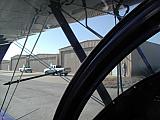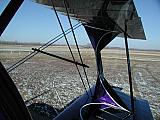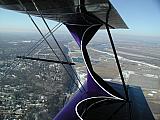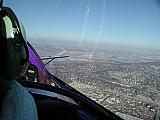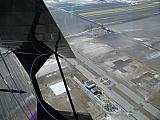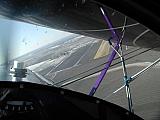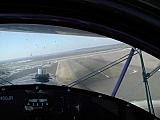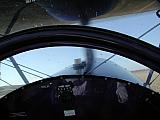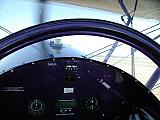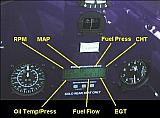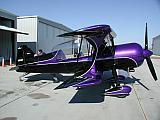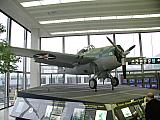My Flight in N80JR - February 2003

After almost 3 years of building I finally got a ride in a Pitts Model 12, too bad it wasn't my own!

I left home about 2100 on friday night and caught
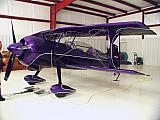 a United 767 all-nighter from San Francisco to Chicago at 2330. Since the airplane was completely full I had to ride up in the cockpit
jumpseat. I put the earplugs in, my coat over my head and leaned against the
cockpit bulkhead and slept as much as possible. It was kinda tough since the crew
kept the lights up bright so they could stay awake and debate all the topics
that crews typically do: world news, company problems etc. during the night.
Also there was the periodic dinging of the intercom when the flight attendants
called, as well as the usual cockpit visits for food and drink to sleep through.
At least I was on the jet. We
got into Chicago about 0545 and I was able to get a little more sleep in the
crew lounge and a cheese omelet before my 0810 flight to St. Louis on a 737. I
don't remember much of the flight, so I must have been sleeping there too. John Ross met me near baggage claim and we made it out to his hangar at
Creve Coeur about 0935. It was sunny, clear, cold (about 38°F) and windy. There was some snow left in the fields
and on the sides of the road too.
a United 767 all-nighter from San Francisco to Chicago at 2330. Since the airplane was completely full I had to ride up in the cockpit
jumpseat. I put the earplugs in, my coat over my head and leaned against the
cockpit bulkhead and slept as much as possible. It was kinda tough since the crew
kept the lights up bright so they could stay awake and debate all the topics
that crews typically do: world news, company problems etc. during the night.
Also there was the periodic dinging of the intercom when the flight attendants
called, as well as the usual cockpit visits for food and drink to sleep through.
At least I was on the jet. We
got into Chicago about 0545 and I was able to get a little more sleep in the
crew lounge and a cheese omelet before my 0810 flight to St. Louis on a 737. I
don't remember much of the flight, so I must have been sleeping there too. John Ross met me near baggage claim and we made it out to his hangar at
Creve Coeur about 0935. It was sunny, clear, cold (about 38°F) and windy. There was some snow left in the fields
and on the sides of the road too.
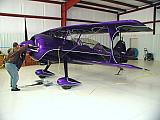 On the way out to airport John mentioned the efforts he has been taking to keep his
engine warm enough in the cold weather, since he has fouled some plugs. He keeps
heater pads plugged in to keep the oil tank and nose case warm, a blanket over the cowl and big pillows in the inlet around the prop. He
also has blocked off the air reaching his oil cooler, but his oil only
gets up to about 140°
On the way out to airport John mentioned the efforts he has been taking to keep his
engine warm enough in the cold weather, since he has fouled some plugs. He keeps
heater pads plugged in to keep the oil tank and nose case warm, a blanket over the cowl and big pillows in the inlet around the prop. He
also has blocked off the air reaching his oil cooler, but his oil only
gets up to about 140°
When we got to the airplane I found that N80JR looked
just as pristine as it did at SNF last year, it is really just a beautiful
airplane! I helped John remove all the bedding and I also got to help him
recharge his air tank with the scuba bottle.
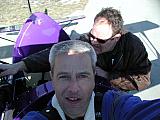 He had flown a short flight the day
before and the engine compressor hadn't had time to recharge the tank above 450
psi, so we put it back up to the 800+ or so it needs. John then pulled the prop
through to make sure he wouldn't get a hydraulic lock due to
oil pooled in the
lower cylinders or intakes. He then ran the primer a bit then pulled some more
blades to get charged air into the cylinders. John had me strap on my chute and then strap in the
airplane first, the hooker harnesses were easy to adjust. John opened the big
hangar door, pulled us out and got in himself.
He had flown a short flight the day
before and the engine compressor hadn't had time to recharge the tank above 450
psi, so we put it back up to the 800+ or so it needs. John then pulled the prop
through to make sure he wouldn't get a hydraulic lock due to
oil pooled in the
lower cylinders or intakes. He then ran the primer a bit then pulled some more
blades to get charged air into the cylinders. John had me strap on my chute and then strap in the
airplane first, the hooker harnesses were easy to adjust. John opened the big
hangar door, pulled us out and got in himself.
With the fuel pump clicking away loudly, John yelled, "Clear" and twisted the key. I could hear the air trying to turn the engine over, but there was a little hesitation as the air had to fight to get the pistons moving. Soon the blades started flipping and it fired, but didn't catch. John tried again....clicking fuel pump - air noise - flipping blades....then VROOOM!. What a great sound that engine makes. The sound of a running M14 is hard to describe, but to me it sounds way better than a Harley or big-block Chevy with a hot cam.
As we taxied out I noticed the visibility straight ahead was nothing but cowl, however the big canopy allowed expansive side visibility to about 10° either side of straight ahead which made determination of the taxi path easy. I noticed John only had to do very shallow s-turns to see ahead. Since he had the oil tank pre-heated, the engine was warm enough to fly by the time we got to the runway and did a run-up. John announced our departure on the radio, lined up and hit it.
Back in high school my friend, Eric Poulsen had a 69' vette with a big-block 454 and a 4-speed. The first time he took me for a ride, he got on a freeway on-ramp and said "watch this!" That car just roared as it smoked the tires in 1st and 2nd gears, then barked them at 60 mph when he shifted into 3rd! It left a lasting impression - so did John's Model 12. That airplane threw me back in the seat and roared just like that vette, except it then pulled up very steep and accelerated! Total takeoff roll was 200 feet tops. We we up at pattern altitude in mere seconds, and set a course away from the STL no-fly zone so we could have some fun. On the way out I shot some pictures, and then got to do some flying.
I found the controls to be light, without slop
and VERY responsive. This smallest movement resulted in airplane movement just
like I had expected from a Pitts. There was no deadband that I could detect and
when I dipped the wing a little it just stayed there until I put it back. Very
nice. I discovered that I could operate the elevator trim handle in the back
cockpit while sitting in the front. It took a little searching
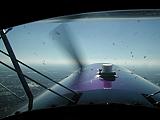 for it, but I found it quicker each time, so I will not consider adding a trim control up
front. The trim was very effective, with only small changes in lever position
being needed. John's airplane doesn't have cabin heat, and we dressed pretty
warmly, but my left hand got cold because I had to rest it up on the longeron
and throttle
where it got a little cold air from outside blown on it. No big deal, but thin
military flight gloves would have made a big difference.
for it, but I found it quicker each time, so I will not consider adding a trim control up
front. The trim was very effective, with only small changes in lever position
being needed. John's airplane doesn't have cabin heat, and we dressed pretty
warmly, but my left hand got cold because I had to rest it up on the longeron
and throttle
where it got a little cold air from outside blown on it. No big deal, but thin
military flight gloves would have made a big difference.
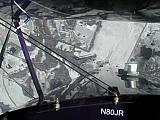 Out in the "freedom zone" I did some steep turns, then a basic aileron
roll. I put the nose up a bit, then added left aileron and rudder, and it came
around very easily. I
only used 50% aileron and it rolled around about the same speed as a Citabria
using FULL muscle. Plus I realized afterwards that I was doing it to the
airplane's "bad" side too! I then did a pretty steep wing-over to get
a feel for pulling up and pulling out, also to build up a little G tolerance
since I hadn't done acro in awhile. It was easy to get the pitch attitude where
I wanted it as the elevator control forces were very light, although I didn't
get a chance to see what they are at full deflection.
Out in the "freedom zone" I did some steep turns, then a basic aileron
roll. I put the nose up a bit, then added left aileron and rudder, and it came
around very easily. I
only used 50% aileron and it rolled around about the same speed as a Citabria
using FULL muscle. Plus I realized afterwards that I was doing it to the
airplane's "bad" side too! I then did a pretty steep wing-over to get
a feel for pulling up and pulling out, also to build up a little G tolerance
since I hadn't done acro in awhile. It was easy to get the pitch attitude where
I wanted it as the elevator control forces were very light, although I didn't
get a chance to see what they are at full deflection.
John then demonstrated some aerobatics and that was the best part! He started off
with a loop, then his 9-yr old daughter's favorite, a Cuban 8. The view out
of that big canopy looking up at the earth was too cool! It was better than an IMAX
movie for sure, my camera with its limited lens certainly did not do the scene
justice by any means.
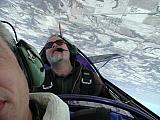
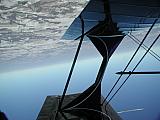 It was also neat to be on the 45° downline upside down,
hanging in the straps and looking up at the snow covered fields below, then see
the big ailerons deflect on the upper wing, making the whole world quickly
rotate back to its normal orientation.
It was also neat to be on the 45° downline upside down,
hanging in the straps and looking up at the snow covered fields below, then see
the big ailerons deflect on the upper wing, making the whole world quickly
rotate back to its normal orientation.
John then ask if I wanted to see a hammerhead, and of course I did, but I had to get my camera ready for a shot looking back. While I was getting the camera turned around, he explained that he wasn't going to use full power, and when I was ready he pulled it up. It still went a long way compared to the Decathlon I last did a hammerhead in. John told me at the beginning of the day he wasn't going to show me any airshow quality aerobatics, but I'm glad he didn't because of what happened next. During the pull up, we had over-rotated a little and actually climbed out on our backs slightly. When he kicked the rudder he also did so a little late, so instead of getting a nice yaw back down, we fell on our backs and the airplane started an inverted spin. John recovered it before it could go more than 1/4 turn, but it gave him the idea to do it again to show how it can't be recovered while the power is left on. He mentioned that it was the most likely scenario that the guys in the red one experienced. So up we went again and this time he let the inverted spin develop.
I think I had just a little sensory overload going on, but man was it fun! All I
could see was the snowy fields spinning above the top wing as I hung in the
straps. I then
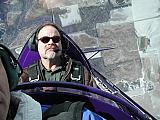 remembered to look down the cowl to determine the rotation
direction for recovery, as I felt John pull the throttle back and the spin
stopped soon afterwards. I could certainly see the value of some spin training
and a knowledge of the emergency spin recovery method that Eugene Beggs outlines
in his book before doing inverted spins on my own. We then did a couple of
upright spins to the right, entered the traditional way. The
Model 12 rotates
pretty fast, but I can't compare it to other Pitts, as this was my first ride in
one. It recovered almost immediately when John applied opposite
rudder. On the
second one John showed me how the addition of power raises the nose to make the
spin go flat, and how it won't come out until you pull the power off. About then
we noticed we were low on time and should head back. It was probably a good thing
because I probably would have pressed on until I barfed, I was having so much
fun. I had also forgotten all about my cold hand! No it wasn't numb from frost
bite.
remembered to look down the cowl to determine the rotation
direction for recovery, as I felt John pull the throttle back and the spin
stopped soon afterwards. I could certainly see the value of some spin training
and a knowledge of the emergency spin recovery method that Eugene Beggs outlines
in his book before doing inverted spins on my own. We then did a couple of
upright spins to the right, entered the traditional way. The
Model 12 rotates
pretty fast, but I can't compare it to other Pitts, as this was my first ride in
one. It recovered almost immediately when John applied opposite
rudder. On the
second one John showed me how the addition of power raises the nose to make the
spin go flat, and how it won't come out until you pull the power off. About then
we noticed we were low on time and should head back. It was probably a good thing
because I probably would have pressed on until I barfed, I was having so much
fun. I had also forgotten all about my cold hand! No it wasn't numb from frost
bite.
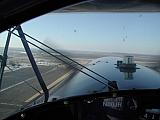
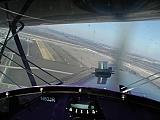
We had mostly moderate chop near the airport on the way back. I found that the Model 12 feels every bump, but once displaced it just stays there, no wallowing around. When a wing got pushed up from a gust it was easy to put it back. Overhead the field, we saw the paved runway had a stiff windsock with a 90° crosswind so John elected to land straight into the wind on the grass one. I certainly didn't want to get any ground-loop pictures either. He flew a very tight pattern, with his downwind leg an estimated 300 feet from runway centerline, and did a nice, tight 180° slipping turn to final at about 105 mph. Then we noticed a black spot at the far end of the runway which turned out to be a helicopter doing some hover practice, so I got to see a go-around. I wish go-arounds were that easy in the jets, John just gassed it and we were up again in a flash! No gear or flaps to mess with, just instant acceleration from the M14 up front.
The helicopter was nice enough to buzz off for our next attempt which resulted in a nice 3 pointer with the tailwheel touching just barely before the mains. During both approaches I found the visibility to be pretty good up front, and I lost sight of the runway only at the very end when John brought the nose up for the flare. Even then it was easy to monitor our spacing down the middle of the strip because the view out the canopy sides is so good. I thought the view from up front was much better than the view I had last month practicing back seat landings in my friend's Decathlon. Writing about the helicopter reminds me how John's tight 180° approach was more like an autorotation than a fixed wing approach. It works very well.
After we taxied back to the hangar, John ran the engine up a bit before killing the engine with the key, since the M14 doesn't have mixture control. He said the run-up reduces the plug fouling and I also remembered reading something about it also allowing the engine driven scavenge pump to get most of the oil out of the crankcase to the tank too. During low rpm oil accumulates in the engine evidently. After it stopped, I got out first and John had me shut the valve on the air tank inside the cowl. He also closed the oil shutoff valve, and ran the electric scavenge pump to completely drain the engine of oil and put it all in the tank. The shut off valve keeps it in the tank, and a microswitch keeps the starter solenoid from energizing unless the valve is open. All this is meant to reduce the possibility of oil pooling in the bottom cylinders and/or intakes and causing a hydraulic lock, which could damage the engine if started. About the time I got the big hangar door open, the electric scavenge pump began to cavitate, signaling that it was done. We then pushed it back into the hangar and John refused my offer to pay for the gas we just burned. All I could do was thank him and tell him that of all my 12,000 hours of flying, that hour was the funnest yet! Sure, my first solo was a great achievement, and the first time I was entrusted with a 30 million dollar jet and a hundred passengers was an honor, but that Model 12 was just plain exciting fun. It was good getting to know John a little bit too.
John dropped my back at Lambert about 1145 and I caught a United Express CRJ up to Chicago then a 767 back home. Of course, I had to pay homage to Butch O' Hare on my way by his Wildcat display in the terminal. I was back at the San Francisco airport about 1745, and home just before 1900.
Looking back I found the Grand Rapids Technologies EIS engine display very useful, and I think I'll use it in my plane. Initially I was concerned about its lack of data tags, but I learned how to operate it pretty quickly and near the end of the flight I found it pretty easy to remember what data it was displaying. It also will display pages with data tags, but only one line of data. Back at the hangar, John had shown me how out of limit data will illuminate his master warning light, and that the EIS will then display the offending numbers with data labels. I like the space it saves on the panel, and the fact that there is less to go wrong with it. I want my airplane to be simple. If I want useless foof, I'll go back to flying the Airbus!
It was great to finally get a ride in a Pitts, and I'm glad to say my first ride was in a Model 12 too. Now I know for sure that I will really enjoy my eventual transition from airplane builder to airplane owner. Twenty two hours, four airliners and one biplane ride later I arrived home convinced that I couldn't have picked a better airplane to build! -- DRB



